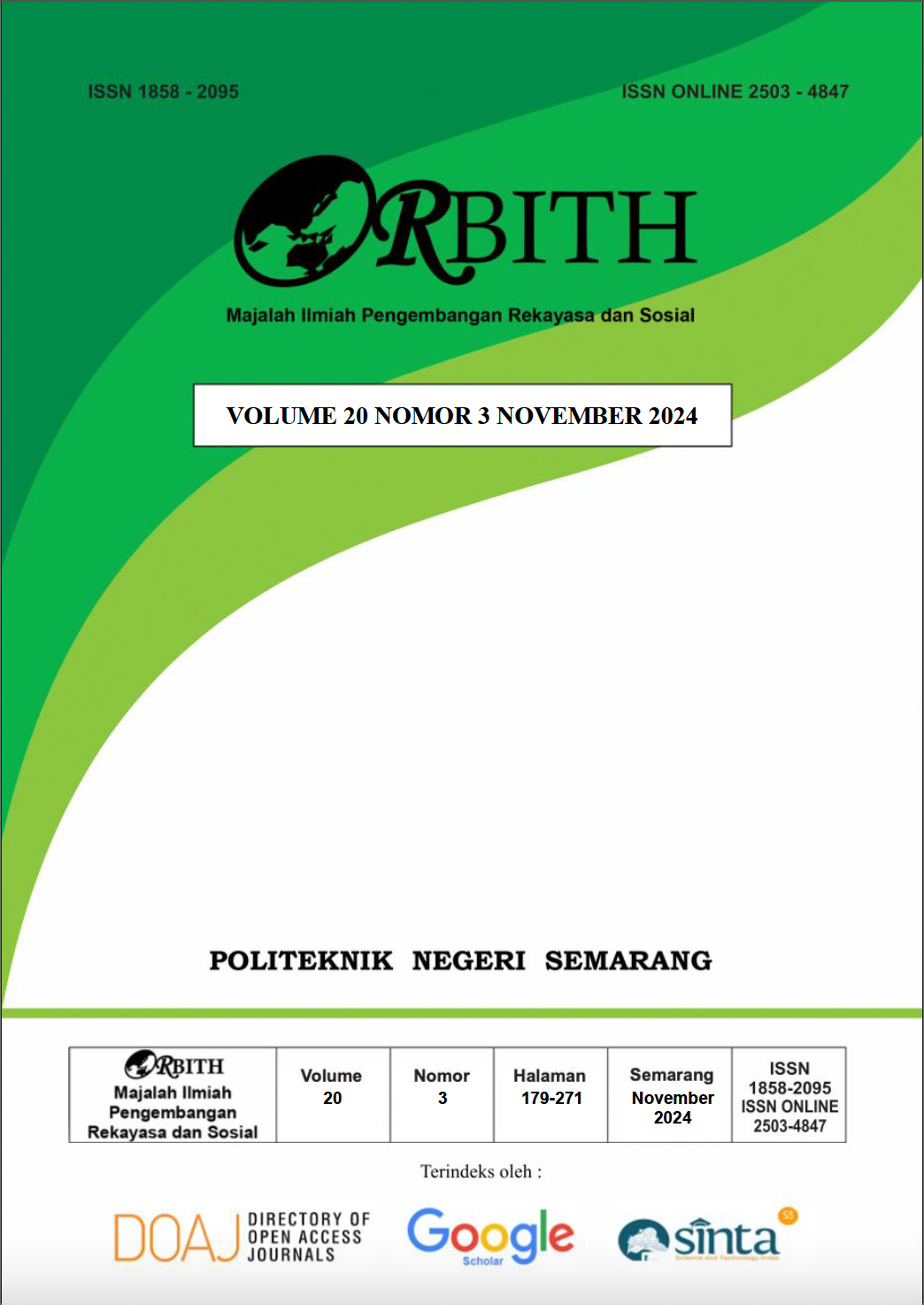PERILAKU BETON NORMAL TERHADAP KOMBINASI BAHAN SUBSTITUSI SEMEN MENGGUNAKAN ABU KELAPA DAN SICA FUME
DOI:
https://doi.org/10.32497/orbith.v20i3.6250Keywords:
Normal concrete, substitution, compressive strengthAbstract
Abstrak Pembuatan beton sesuai standar sangat ditekankan terutama untuk menghasilkan kuat rencana yang diinginkan, seperti menggunakan standar untuk campuran beton normal dengan SNI 03-2834-2000. Standar pemilihan bahan campuran terutama semen merupakan bahan sangat penting terutama sebagai bahan pengikat antara agregat dengan air dalam membuat beton normal. Salah satu aspek yang paling penting untuk diketahui dari pembuatan beton adalah mengetahui kekuatan tekan betonnya. Dan kekuatan tekan beton sangat dipengaruhi oleh jenis semen yang digunakan, proporsi, dan rasio air-semen dalam campuran. Dalam penelitian ini dilakukan pengujian laboratorium beton terhadap kombinasi bahan substitusi semen menggunakan abu kelapa dan sica fume untuk mengetahui kuat tekan betonnya dengan metode uji untuk kekuatan tekan spesimen beton silinder SNI.1974:2023. Kombinasi bahan substitusi semen menggunakan abu kelapa dan sica fume ini terdiri dari 5 variasi, yakni variasi 1 (100% semen), variasi 2 (94% semen, 3% abu kelapa, 3% sica fume), variasi 3 (90% semen, 5% abu kelapa, 5% sica fume), variasi 4 (86% semen, 7% abu kelapa, 7% sica fume), dan variasi 5 (80% semen, 10% abu kelapa, 10% sica fume). Hasil pengujian menunjukkan bahwa semakin bertambah umur beton maka nilai kuat tekan beton semakin bertambah, yakni di atas nilai rencana kuat tekan 25 MPa untuk umur beton 28 hari untuk variasi 1 sampai dengan variasi 5 dengan nilai rata-rata kuat tekan beton 35,93 MPa. Kemudian berdasarkan kombinasi bahan substitusi semen menggunakan abu kelapa dan sica fume menunjukkan variasi 4 dengan abu kelapa (7%) dan sica fume (7%) merupakan kombinasi terbaik yang direkomendasikan karena memiliki nilai kuat tekan beton pada umur beton 21 sebesar 40,93 MPa dan pada umur beton 28 hari sebesar 40,16 MPa tertinggi dibanding dengan variasi lainnya. Kata kunci: Beton normal, substitusi, kuat tekan Abstract The production of concrete according to standards is emphasized, especially to achieve the desired design strength, such as using the standards for normal concrete mixtures as outlined in SNI 03-2834-2000. The selection of mixture materials, particularly cement, is crucial as it serves as the binding agent between aggregates and water in creating normal concrete. One of the most important aspects to understand in concrete production is determining its compressive strength. The compressive strength of concrete is significantly influenced by the type of cement used, the proportions, and the water-cement ratio in the mixture. This study conducted laboratory testing on concrete with a combination of substitute materials using coconut ash and silica fume to determine the compressive strength of concrete through the testing method for cylindrical concrete specimens according to SNI 1974:2023. The combinations of substitute materials using coconut ash and silica fume consist of five variations: Variation 1 (100% cement), Variation 2 (94% cement, 3% coconut ash, 3% silica fume), Variation 3 (90% cement, 5% coconut ash, 5% silica fume), Variation 4 (86% cement, 7% coconut ash, 7% silica fume), and Variation 5 (80% cement, 10% coconut ash, 10% silica fume). The test results indicate that as the age of the concrete increases, the compressive strength also increases, exceeding the target design strength of 25 MPa at 28 days for Variations 1 through 5, with an average compressive strength of 35.93 MPa. Furthermore, based on the combinations of substitute materials using coconut ash and silica fume, Variation 4 with 7% coconut ash and 7% silica fume is recommended as the best combination, as it exhibits the highest compressive strength at 21 days of 40.93 MPa and at 28 days of 40.16 MPa compared to the other variations. Keywords: Normal concrete, substitution, compressive strengthReferences
Ajmani, Haitham Al,dkk.2019. Evaluation of Concrete Strength Made with Recycled Aggregate. Journals Buildings Volume 9 Issue 3.MDPI.
Ayanlere,S.A, dkk.2023. Effects of water-cement ratio on bond strength of concrete. Proceeding of 1st International Conference on Advances in Cement and Concrete Volume 86.
BSN. 2023. Metode uji untuk kekuatan tekan spesimen beton silinder (ASTM C39-20, IDT). SNI. 1974:2023.
BSN. 2000. Tata cara pembuatan rencana campuran beton normal, SNI 03-2834-2000, Badan Standarisasi Nasional Indonesia, Jakarta.
Dumyati, A., & Manalu, F.D. (2015). Analisis Penggunaan Pasir Pantai Sampur Sebagai Agregat Halus Terhadap Kuat Tekan Beton. Jurnal Fropil Vol.3 Nomor 1 Januari-Juni 2015. Alumni Jurusan Teknik Sipil Universitas Bangka Belitung.
Fernando, Robi,dkk. 2022. Studi Perbandingan Mutu Beton Normal Berdasarkan variasi Pengambilan Agregat Kasar di Provinsi Jawa Tengah. Jurnal Orbit Vol.18 No.1 Politeknik Negeri Semarang.
Firda, Ani, dkk. (2021). Pemanfaatan Limbah Batubara (Fly Ash) Sebagai Materian Pengganti Agregat kasar Pada Pembuatan Beton Ringan. Jurnal Deformasi.Vol.6 No.1,Universitas PGRI Palembang.
Hunggurami, E., Bolla, M. E., & Messakh, P. (2017). "Perbandingan Desain Campuran Beton Normal Menggunakan SNI 03-2834-2000 dan SNI 7656:2012". Jurnal Teknik Sipil, VI(2), Universitas Nusa Cendana Kupang.
Mahmud, Hilmi, dkk. 2009. Mechanical Properties and Durability of Normal and Water Reduced High Strength Grade 60 Concrete Containing Rice Husk Ash.Journal of Advanced Concrete Technology Vol. 7, No. 1, 21-30, February 2009. Japan Concrete Institute.
Neville, A. M. 2011. Properties of Concrete (5th ed.). Pearson Education.
Purwanto, H., & Wardani, U. C. (2020). Pengaruh Penambahan Serbuk Besi Terhadap Kuat Tekan Beton Mutu K225.Jurnal Deformasi,5(2), Universitas PGRI Palembang.
Rocco, C.G., and Elices, M., (2009), Effect of Aggregate Shape on the Mechanical Properties of a Simple Concrete, Engineering Fracture Mechanics, 2009, 76(2).
Shcherban, Evgenii M, dkk.. 2022. Normal-Weight Concrete with Improved Stress”“Strain Characteristics Reinforced with Dispersed Coconut Fibers.Journals Applied Sciences Volume 12 Issue 22. MDPI.
Singh, M., & Siddique, R. (2020). Effect of water/cement ratio on the properties of self-compacting concrete containing recycled coarse aggregate. Journal of Construction and Building Materials.
Sosa, Maria E,dkk.2021. A critical review of the resulting effective water-to-cement ratio of fine recycled aggregate concrete. Journal of Construction and Building Materials Volume 313, 27 December 2021.
Sutrisno, dkk. 2020. Strength reduction factor evaluation of the circular reinforced concrete column with varying eccentricity ratio (e/h).Journal of Civil Engineering Vol.35 No.1. ITS.
Xu, Hongyin, dkk. 2019. Self-Healing concrete Using Rubber Particles to Immobilize Bacterial Spores. Journal Materials, Volume 12, Issue 14 (July-2 2019).MDPI.
Downloads
Published
Issue
Section
License
Authors who publish with this journal agree to the following terms:Authors retain copyright and grant the journal right of first publication with the work simultaneously licensed under a Creative Commons Attribution License that allows others to share the work with an acknowledgement of the work's authorship and initial publication in this journal.
Authors are able to enter into separate, additional contractual arrangements for the non-exclusive distribution of the journal's published version of the work (e.g., post it to an institutional repository or publish it in a book), with an acknowledgement of its initial publication in this journal.
Authors are permitted and encouraged to post their work online (e.g., in institutional repositories or on their website) prior to and during the submission process, as it can lead to productive exchanges, as well as earlier and greater citation of published work (See The Effect of Open Access).






